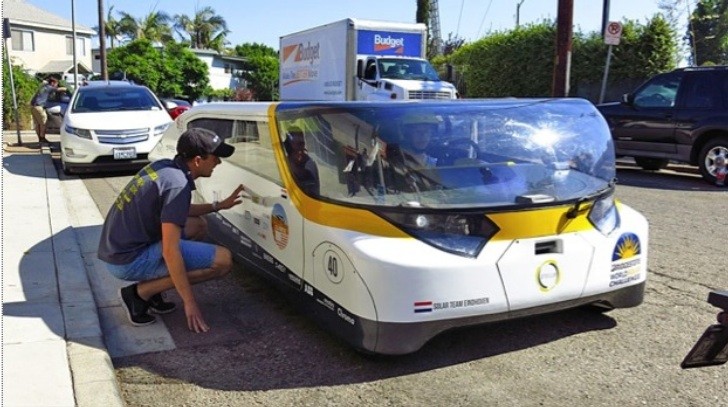You’ve seen these solar-panel-plated lightweight vehicles competing in green races, but all of them came with limitations regarding passenger comfort and number of seats. However, Stella here wants to solve the problem soon.
The road so far
Relying only on solar power to run a vehicle means it has to be very light, since the limited solar cell covered area will provide a rather small amount of power compared to your huge roof-mounted solar array at home, for example. That’s why most of the solar EVs are single seaters and made out of thin, lightweight parts.
Then comes drag and rolling resistance, which need to be kept at a minimum to make the most out of the power generated. Which basically means the car will be very low, narrow and roll on bicycle wheels, all translating into an uncomfortable ride.
This happened for about 20 years in the world of solar-powered prototypes, but then, a group of students from the Eindhoven University of Technology in the Netherlands decided something should be done if we really want to make sun EVs happen.
It took the team one and a half years to design and build the car. As with other concepts, Stella is built on a lightweight tubular frame and has a low slung body shell, which unlike the rest, is wider and reminds us more of an aerodynamic box than a sleek teardrop.
This allowed the researchers to mount more solar panels on its top and rear, while also offering enough interior space for four passengers and a large battery pack sitting right in the middle. It’s still cramped, but at least it is more practical than other models.
When it’s full, the 15 kWh Panasonic lithium-ion battery backed up by the solar panels offers Stella a 500-mile (800 km) range and a top speed of 75 mph (120 km/h); more than what you would expect or need for a daily commute.
A world record isn’t the only thing the team looks after, though. Coming to the US for the first time, Stella is also aimed at raising interest among investors, as the team wants to turn the concept into a production version in about 5 to 10 years.
For the uninitiated, the National Drive Electric Week is a free coast-to-coast event celebrating and showcasing the advantages and fun electric vehicles can provide.
Relying only on solar power to run a vehicle means it has to be very light, since the limited solar cell covered area will provide a rather small amount of power compared to your huge roof-mounted solar array at home, for example. That’s why most of the solar EVs are single seaters and made out of thin, lightweight parts.
Then comes drag and rolling resistance, which need to be kept at a minimum to make the most out of the power generated. Which basically means the car will be very low, narrow and roll on bicycle wheels, all translating into an uncomfortable ride.
This happened for about 20 years in the world of solar-powered prototypes, but then, a group of students from the Eindhoven University of Technology in the Netherlands decided something should be done if we really want to make sun EVs happen.
Stella
So they came up with Stella, a four-seater solar-powered vehicle that can actually produce more energy than it consumes. And the coolest thing with it is that it’s made with current technology.It took the team one and a half years to design and build the car. As with other concepts, Stella is built on a lightweight tubular frame and has a low slung body shell, which unlike the rest, is wider and reminds us more of an aerodynamic box than a sleek teardrop.
This allowed the researchers to mount more solar panels on its top and rear, while also offering enough interior space for four passengers and a large battery pack sitting right in the middle. It’s still cramped, but at least it is more practical than other models.
When it’s full, the 15 kWh Panasonic lithium-ion battery backed up by the solar panels offers Stella a 500-mile (800 km) range and a top speed of 75 mph (120 km/h); more than what you would expect or need for a daily commute.
Achievements
The car won the 2013 World Solar Challenge in the Michelin Cruiser Class and now it aims to woo Americans too. Stella officially started the National Drive Electric Week and will drive in Cupertino’s National Drive Electric Week event on September 20th in order to attempt to break the world record.A world record isn’t the only thing the team looks after, though. Coming to the US for the first time, Stella is also aimed at raising interest among investors, as the team wants to turn the concept into a production version in about 5 to 10 years.
For the uninitiated, the National Drive Electric Week is a free coast-to-coast event celebrating and showcasing the advantages and fun electric vehicles can provide.




